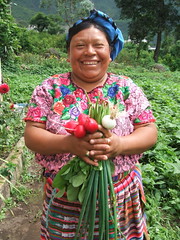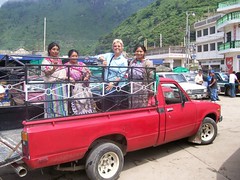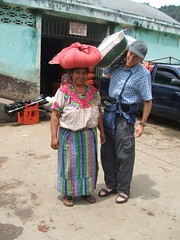Women we visited in La Estancia de la Cruz

Berta in La Estancia
The women we visited Tuesday in La Estancia de la Cruz have been working in the fields all their lives and they know no other way to make a living. As young children they did not go to school because they needed to help the family in the fields. The land here is very rich because the volcanic soil and the 6 months of rain.
None of the women we met with today own their own land. They rent a plot and also work for someone else. With the help from Friendship Bridge, the women are able to rent a 40'x40' plot and grow their own flowers and vegetables. They have a chance to dream and maybe educate their children if there is enough money to buy shoes, paper, pencils and needed supplies. Currently some families do not send their children to school either because they need the help in the field or they just do not have the money to send the children to school.
The month of July is known as the hunger time because the food they had stocked piles are nearly depleted The growing season is February to August and they corn is not ready to harvest.
After interviewing the women, writing their individual stories and taking wonderful photographs of the women in their traditional colorful Mayan clothing, we got ready to leave. One woman stood in the middle of the concrete block room, just a few feet away from us asked if we could help the group of 20 women with some food. Randy and I looked at each other and were taken by surprise at this humble request. We asked what kind of food they needed. She replied that they where thinking of rice, beans, corn, oil and sugar. After Randy and I talked a bit we agreed and set an amount we where willing to help out with which was 250 Queztals.

In the bus with the women
Three women from the group took us out to the main road and we climbed in the back of pickup, the standard taxi or local bus in this area. We travelled for 10 miles up and over the ridge and down to the market place in the village of Zunil.
Randy explained in Spanish that what he and I had agreed and the women could decide how to spend it. They could spend it on rice, corn, oil, and sugar or any combination They math was somewhat hard for these women but the three women worked together and worked on the market vendors to give them the best price for the money. In the end they bought 40 pounds of sugar and one bag of 100 lbs of dried corn. This would be divided up among 20 families. We thought later 100 pounds was not really enough and we should have bought another 100lbs.
As I was standing there wondering how these women would carry a hundred pounds sack of corn, all three women took off their shawls and started filling it with the dried corn. When each shawl had 20lbs of dried corn, they tied the shawl up and put the bundle on top of heads and balanced the load. Randy carried out the remaining corn on his shoulder to the taxi loading area. The women gave us hugs and kisses, thanking us for the help and wished us luck on our journey back to Quetzaltango.

Corn on her head and Randy's shoulder
As we walked to the bus stop, I thought of what and amazing experience to be able to help out in this way. To be able to meet these women in their homes, see the reality of their need. And then get in a pickup truck to the village and go with them while they picked out the most needed items for the women and their families.
I have given money to charity in far off places before and it did give me a wonderful feeling. But this was far more amazing. I could not believe we could experience giving to this extent and to really understand the need and the impact.
If you wonder how much 200 Quetzals is, it is about what a family in the United States would pay to go out to the movies, not including popcorn, drinks or candy. Or it is equal to the cost of a couple of pizzas.
